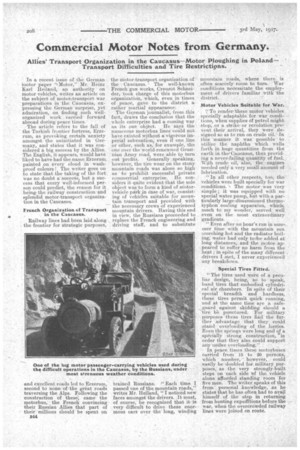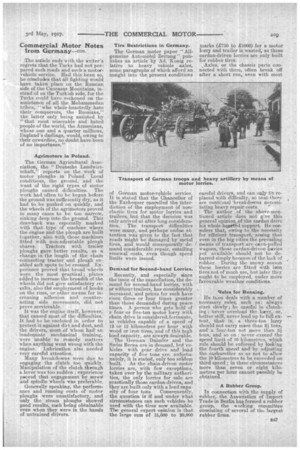Commercial Motor Notes from Germany.
Page 12

Page 13

If you've noticed an error in this article please click here to report it so we can fix it.
Allies' Transport Organization in the Caucasus—Motor Ploughing in Poland— Transport Difficulties and Tire Restrictipns.
In a recent issue of the German Motor paper "-Motor," Mr. Heinz Karl Reiland, an authority • on motor vehicles, writes an article on the subject of motorztransport war preparations in the Caucasus, expressing the German surprise, jet admiration, on finding such wellorganized work carried forward abroad during peace times. The article refers to the fall of the Turkish frontier fortress, Erzerum, as provoking certain -anxiety amongst the uninitiated in Germany, and states that it was considered a big success by the Allies. The English, it appears, would have liked to have had the name Erzerum, painted .on every cloud in . washproof colours The writer goes on to state that the taking of the fort was no doubt a success, but a success that every well-informed person could predict, the reason for it being. the railway construction and splendid motor-transport organiza
tion in the Caucasus. , French Organization of Transport in the Caucasus.
Railway lines had been laid along the frontier for strategic purposes,
and excellent roads led to Erzerum, second to none of the great roads traversing the Alps. Following the construction of these; came the motorbus, the French convincing their, Russian Allies that part of their millions should V be spent on
B44
the motor-transport organization of the Caucasus. ' The well-known French gun works, Creuzot Schneider, took charge of this motorbiis organization, which, even in -times of peace, gave to the district a rather martial appearance.
The German journalist, from :this fact, draws the conclusion that the whole enterprise had a coming war as its one object. He says the numerous motorbus lines could not have existed without a vigorous imperial subvention, even if one .line or other, such as, for example. the one over the world-renowned drusiMan Army road, were able to turn
out profits. Generally apelking, however, the tire wear on the stony mountain roads was alone so high as to prohibit successful private commercial enterprise. He considers it quite evident that the sole object was to form a kind of MotorVehicle park in ease of war, consisting of vehicles suitable for moantarn transport and provided with the necessary crews of experienced mountain drivers. Having this end in view, the Russians proceeded to replace the French engineering and driving staff, and to substitute
trained Russians. "Each time I passed one of the mountain roads," writes Mr. Heiland, "I noticed new faces amongst the drivers. It must, of course, be recognized that it is very difficult to drive these enormous cars over the long, winding mountain, roads, where there. is often scareely room to turn. War conditions necessitate the employment of drivers familiar with the district.
Motor Vehicles Suitable or War.
, (4‘ To render, these motor vehicles specially adaptable for war conditions, when supplies of petrol might stop, or a strike or revolution, pre: vent their .arrival, they were' designed so as to rim on crude oil. In this manner it was possible to utilize the naphtha 111.i. eh wells forth in huge quantities from the earth in the-C.a.ucasus, thus providing a neverLfailing quantity of fuel. With crude oil, also, the engines needed onlY a very small amount of lubrication.
"In all other respects, too, the vehicles were built specially for war conditions. 's The motor was very simple ; it was equipped with no special water pump, but with a particularly large-dimensioned thermosyphon cooling apparatus, which; much to my wonder, served well even on the most extraordinary gradients.
"Even after an hour's run in sum,, mer time with the mountain sun scorching hot and the radiator boiling; water had only to be added at long distances, and the motor appeared to suffer no harm from the heat ; M spite of the many different drivers I met, I never experienced any breakdown.
Special Tires Fitted.
"The tires used were of a peculiar design, being, so to speak, band tires that embodied cylindrical air chambers. In spite of their • special breadth and hardness, these tires permit quick running, and at the same time are a safe, guard. against skidding' should a 'tire bb punctured: For military purposes these tires liad the -further advantage that they could stand overloading of the lorries. Even the springs were long and of a Specially strong construction,in order that they also could support any 'undae overloading."
In peace times these Motorbuses carried from . 15 to 20 persOna, which number, however, could easily be -doubled for. militar purPoses,as the very V strongly-built steps 041 each side bf the vehicle alone afforded standing . room for five men. The writer, speaks of this from personal „knowledge, as he states that he has often had to avail himself of the step in returning from hunting expeditions before the war, when the overcrowded railway lines were Joined en route.
• The article ends with the writer's regrets that the Turks had not prepared such roads and such a motorvehicle service. Had this been so,
heC0neludes that all fighting would have taken place on the Russian • side of the Caucasus Mountains, instead of on the Turkish side, for the Turks could have reckoned on the assistance of all the Mohammedan tribes, " who whole-heartedly . hate their conquerors, the Russians," the latter only being assisted by "that most miserable • and hated people of the world.; the Armenians, whose one and a quarter millions; England's darlings, would, owing to their cowardice, no doubt have been of no importance."
Agrimotors in Poland.
The German Agricultural Association, the "Deutsche Landwirtschaft," reports on the work of motor ploughs in Poland. Local conditions, the ground, and the want of the right types of motor ploughs caused difficulties. The work had often to be begun before the ground was sufficiently dry, as it had to be pushed on quickly, and the wheels of the agrimotors proved in many cases to be too narrow, sinking deep into the ground, This drawback was especially marked with that type of machine where the engine and the plough are built together, also with those machines fitted with non-adjustable plough shares. Tractors with trailer ploughs gave better results, as a change in the length of the chain -connecting tractor and plough enabled soft spots to be crossed. :Experience proved that broad wheels were the most practical ; plates added to increase the breadth of the wheels did not give satisfactory re • salts, also the employment of hooks on the rims, or other means for increasing adhesion and counteracting side movements; did not prove serviceable.
It was the engine itself, however, that caused most of the difficulties. It had to be enclosed in order to protect it against dirt and dust, and the drivers, most of whom had an inadequate Mechanical training, were unableto remedy matters when anything went wrong with the engine. Lubrication also needed very eareful attention.
Many breakdowns were due to engaging the clutch too quickly. Manipulation of the clutch through a lever was too sudden ; experience pmoved that engagement by scravi and spindle wheels was preferable.
Generally speaking, the performance and running costs of motor ploughs were unsatisfactory, and only the steam ploughs showed good results, such being obtainable even when they were in the hands of untrained drivers. Tire Restrictions in Germany.
The German .motor paper " Allgemeine Automobil Zeitung " publishes an article by Ad. lionig relative to heavy vehicle axles, some paragraphs of which afford an insight into the present conditions of German motor-vehiele service. It is stated that the Chancellor of the Exchequer cancelled the interdiction of the employment of nnelastic tires foi. motor lorries and trailers, butt that the decision was only arrived at after long consideration. The transport difficulties were many, and perhaps. undue attention was given to the fact that roads might be damaged by metal tires, and would consequently detnand considerable repair, entailing renewal costs, even though speed limits were issued.
Demand for Second-hand Lorries.
Recently, and especially since the issue of the cancellation, the demand for second-hand lorries, with or without trailers, has considerably increased, and prices for such have risen three or four times greater than those demanded during peace times. A person who gets hold of four or five-ton motor lorry with chain drive is considered.fortnnate, as vehicles capable of a speed of 12 or 12 kilometres per hour with wood or iron tires, and of this -high load capacity, are aiway§ desirable. _ The German Daimler and the Swiss Boma. are in demand, but vehicles with gear drive' and /odd capacity of five tons are. tin Fortue nately, it is stated, only too seldom built. As the chain-driven motor lorries are, with few exceptions, taken over by the military authorities, the only lorries for sale are practically those cardrin-driven, and they are built only with a load capa
city of four tons Consequently, the question is if and under what eircamstances can such vehicles be used with the tires now available. The general expert .opinion is that the large sum of 15,000 io 20,000
marks (2750 to £1000) for a motor lorry and trailer is wasted, as these cardan-driven lorries are only built for rubber tires.
Axles, or the chassis parts connected with them, often break off after a short run,, even with most careful drivers, and can only i7e replaced with difficulty, so tnat there are continual 'breakdowns necessitating heavy repair costs.
The author of the above-mentioned article does not eve this general opinion of the eardan drive his whole-hearted support. He considers that, owing to the necessity for efficient trarisvort, seeing that even in the big cities the prevailin 4 means of transport are orcen-pulle wagons, those cardan-driven lorries yet available should not be debarred simply because of the lack of rubber. During the snowy season these lorries are fitted with iaon tires not of much use, but later they ought to be employed, under more favourable weather conditions.
Rules for Running.
He teen deals with a number of necessary rules, such as : always start slowly; be caaeful in clutching; never overload the. lorry, or, better still, never load up to full extent, thatis, a three-ton lorry should not carry more than WI tons, and a four-ton not more . than 3?2• tons, and so on; never exceed the speed limit of 10 kilometres, which ride should be enforced by locking the fourth speed and by. adjusting the carburetter so as not to allow the 10 kilometres to be exceeded on third speed ; in these circumstances more than seven or eight kilometres per hour cannot possibly be obtained.
A Rubber Group.
In connection with the supply of rubber, . the Assnciation of Import Trade in Berlin ha-formed a rubber group, the working committee consisting of several of thb largest rubber firms.






















